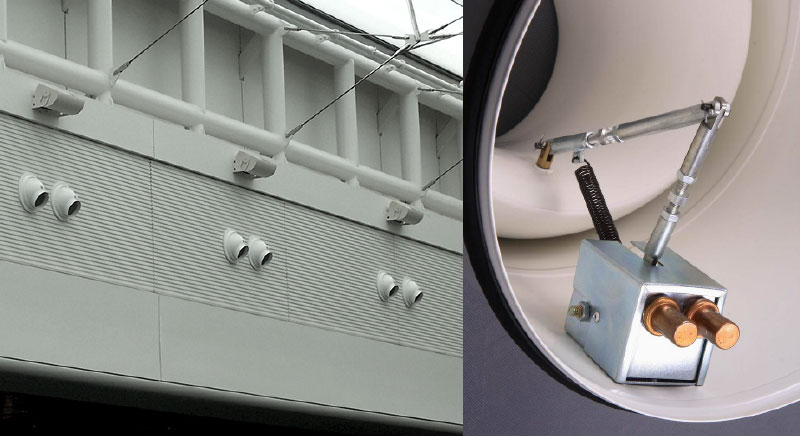Modican PLC controller is widely used in ETS system, and this type of PLC control system runs stably and has high reliability. However, with the development and upgrading of power process control system, the original Modican PLC control system has appeared many hidden dangers affecting the safe operation of equipment and system, such as hard trip of this ETS system. There is a risk of power failure protection rejection; communication network is not fully independent of redundant configuration, does not have interference-free switching function, etc. These serious equipment defects have been unable to meet the relevant provisions of “Twenty-five Key Requirements for Preventing Electric Power Production Accidents”. As an important unit protection system, the emergency trip system (ETS) of steam turbine should be designed to lose power in the unit trip circuit. Meanwhile, the system itself should have measures to prevent misoperation and protect misoperation. Our company’s Modikon PLC controller has not met the relevant provisions of “Twenty-five Key Requirements for Preventing Electric Power Production Accidents” in terms of equipment hardware and protection configuration. The original ETS control system of Unit 4 of Datang Sanmenxia Power Generation Co., Ltd. is Modikang PLC controller. The system was put into operation in 2006. The whole system integrates PLC dual hot standby controller, I/O card, touch screen upper computer and other configurations.
In 2015, the power supply system of the whole system was reformed, and the single distribution power supply module was upgraded to Xixi. Portal 24VDC dual power switching power supply system. The system is equipped with 110 VDC AST tripping circuit and power supply circuit of each extraction backstop. According to the requirements of Article 9.4.8, 9.1.2 and 9.4.3 of “Twenty-five Key Requirements for Preventing Electric Power Production Accidents”, “The trip relay of steam turbine emergency tripping system should be designed to operate out of power, the hard-handed equipment itself should have measures to prevent misoperation and unreliable operation, and the manual shutdown protection should be independent of the decentralized control system (or may) Programming Logic Controller (PLC) Hard Trip Control Circuit of Device; “The controllers, system power supply, DC power supply for I/O module and communication network of DCS adopt completely independent redundancy configuration, and have the function of non-disturbance switching;”All important main and auxiliary protection should adopt the logical judgment of “three to two” The protection signal should follow the principle of relative independence from sampling point to input module. The number of measuring points is insufficient due to system reasons, and measures should be taken to prevent misoperation of protection. The original ETS system of Unit 4 of Datang Sanmenxia Power Generation Co., Ltd. does not meet the requirements of technical specifications in terms of protection configuration and hardware configuration. There is a high risk of protection malfunction and refusal to operate, which requires a comprehensive system upgrade. Emerson’s Ovation controller is powerful in the process control of power system. The controller can perform multi-task, multi-system compatibility operation and execution functions on demand, and is suitable for performing key program control tasks. At the same time, the controller can achieve complete disturbance-free switching. The control system integrates the SOE system (historical event sequence). The resolution of the SOE record user-set digital input change state sequence is 1/8 milliseconds. At the same time, the controller of the control system can meet the redundancy requirements of different devices. The redundancy configuration of the Ovation controller mainly includes: network interface; functional processor, memory and network controller; processor power supply; I/O interface; input power supply; I/O power supply; auxiliary power supply; remote I/O and so on. The hardware of the Ovation controller is configured on the compatible communication and power supply backup board.
The main controller and backup controller are installed. The redundant 24V power supply is powered by two controllers respectively. Each controller contains two modules, one module unit is equipped with processor, memory and network port, and the other module unit is equipped with local port. And remote Ovation and Q Line I/O interface, internal power supply and so on. Each controller executes the same application, thermostatic element but only one controller can communicate with I/O and run in the main control mode, while the backup controller runs in the backup, configuration and offline mode. These two modes are called “control mode” and “backup mode”. In the control mode, the main controller is a non-redundant processor, which can read, write and execute data acquisition and control functions directly. In addition, the master controller monitors the state of the backup controller and the network. At the same time, in the backup mode, the backup controller diagnoses and monitors the status of the main controller. The backup controller maintains the latest data needed for control, and obtains the information from all the control processors through the Ovation network, including the process point data, the parameters of the algorithm block and the attributes of the variable points. The original Modican’s PLC control system is transformed into the DCS control system of Ovation. The protection system is equipped with independent power module, main and standby controllers and I/O cards.
During the operation of the main controller, the sub-controllers are standby, and the main and sub-controllers realize the disturbance-free switching. The main protection signal of the unit enters into the ETS protection system of Ovation, and executes relevant logic operations in the system. When each protection signal reaches the protection action value, the trip instruction is transmitted to the AST action instruction unit. Four independent AST relay cards act to execute the trip instruction. At the same time, the action signal is eventually output to DCS system through DO card for subsequent chain action logic and alarm display. The four AST tripping solenoid valve circuits in the original ETS protection tripping hard wiring circuit are DC 110VDC control circuit, AST1, AST3 are a group, AST2, AST4 are a group, and the main protection circuit is deactivation. The main circuit of AST operates through the tripping intermediate relay.
The intermediate relay circuit is a 24V control circuit. The circuit includes two parts: manual switching off and PLC output protection action. Problems in this circuit: once 24V power supply is lost, manual switching off and PLC output protection action will fail, resulting in the unit will not be able to safely switching off. After modification, the ETS system directly drives the 110VDC control circuit, manual switching and ETS tripping are increased to this circuit. The AST tripping circuit is still powered independently by two 110VDC circuits. The tripping node is the normal open node of the 110VDC ETS system tripping relay. When the 110VDC ETS system tripping relay is energized during normal operation of the unit, the tripping circuit is turned on, and the AST solenoid valve is turned on. When the unit trips or ETS system loses power, the tripping circuit is disconnected and the AST solenoid valve loses power. There are 20 main protections in ETS system: EH oil pressure is low; lubricating oil pressure is low; high pressure condenser vacuum is low; low pressure condenser vacuum is low; axial displacement is large; bearing vibration is large; TSI overspeed; DEH overspeed; high row temperature; bearing temperature is high; manual braking; generator fault; MFT; low turbine pressure ratio; on-site braking; main steam temperature sudden drop again; Hot steam temperature drop suddenly; generator main oil switch is off; main oil tank oil level is low; DEH power loss. After the transformation of ETS system, all protective signals are relatively independent from sampling point to input module, and input to three independent signals of Ovation system. The logic judgment output of “three take two” is completed in Ovation system logic, which ensures the reliability of signal and protection.

AST solenoid valve activity test, main engine lubricating oil low test, EH oil pressure low test, vacuum low test and other operation tests, in the original ETS system, need to be operated and monitored in the integrated engineering machine of Modikon PLC.
This test mode is very disadvantageous to the monitoring and operation of operators and test personnel, and relevant tests are not entered into DCS system. Generally, it is impossible to collect and analyze the relevant data during the experiment.

Taking advantage of the opportunity of upgrading and renovation of ETS system, the operation modes of AST solenoid valve activity test, main engine lubricant low test, EH oil pressure low test and vacuum low test are moved from ETS system to DCS system.
Logic protection is configurated in Ovation system of ETS, which ensures the reliability of logical configuration and also makes operation mode possible. Convenient and intuitive. After the hardware installation of the new Ovation system has been completed, a series of system tests have been carried out, including the functions of the system after establishment; information validation; I/O test; network and controller redundancy function test; function station test, network function test; upper computer function test, cabinet grounding test and so on.

With the start-up operation of the unit, ETS system runs steadily. Under the condition of stable operation of the system, system performance indicators have been tested successively. All system indicators meet the relevant technical requirements and specifications. The stability and safety of the unit have been greatly improved after the modification of ETS system.
